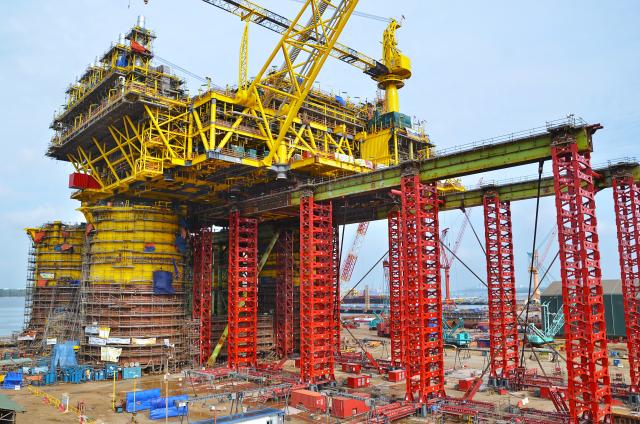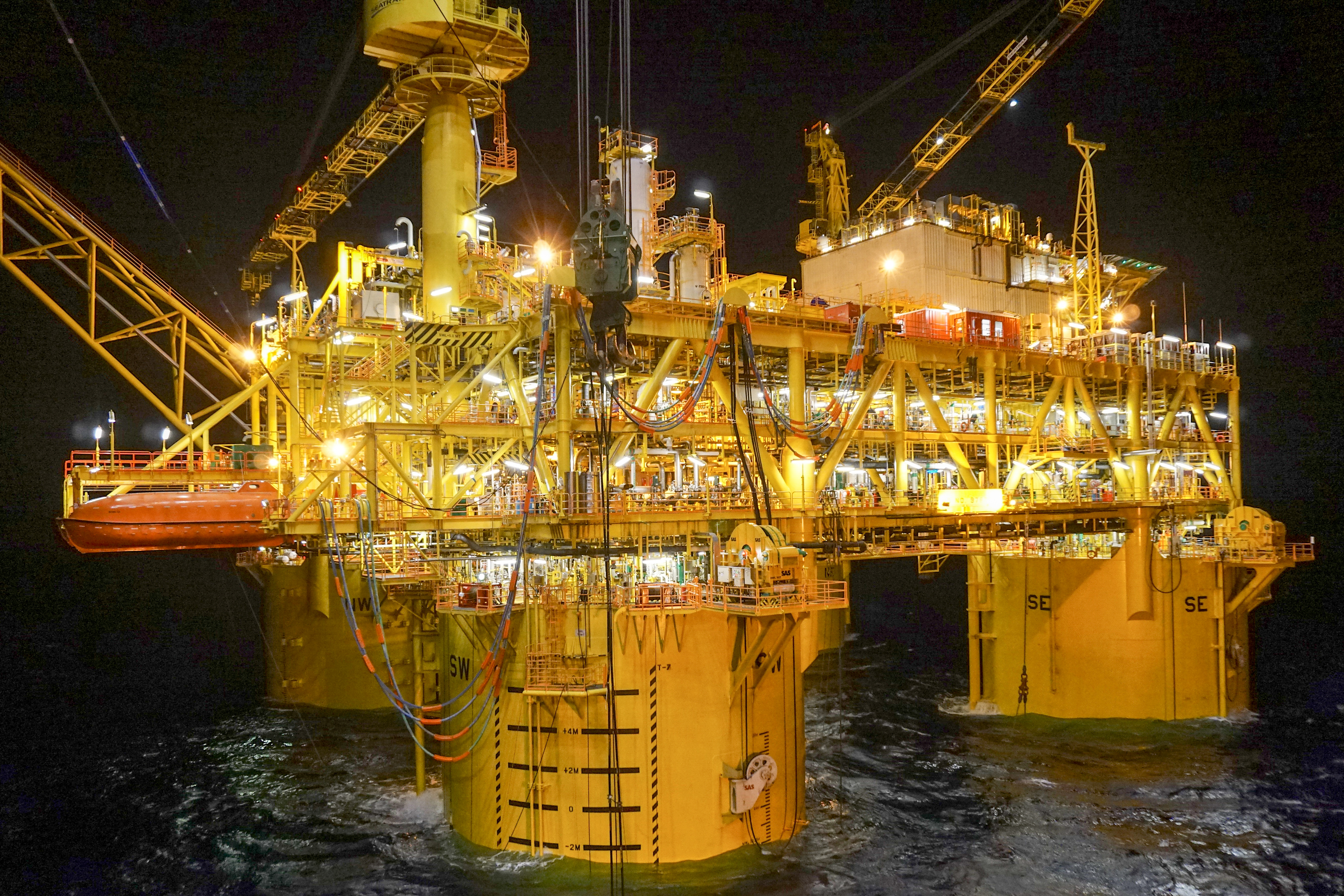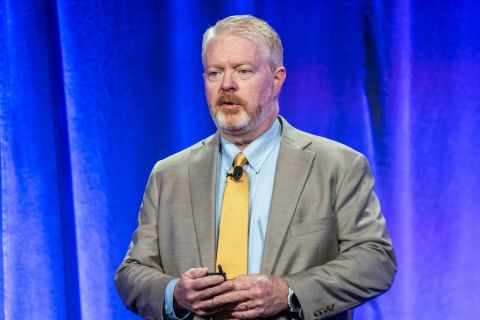
In 2015 Shell’s project team jacked up the topsides to skid them onto the platform legs in the fabrication yard at Pasir Gudang, Malaysia. According to Shell, the “superlift” was the world’s highest jacking and skidding operation for a platform of its scale. (Source: Shell)
This year’s Offshore Technology Conference (OTC) held in early May in Houston featured several sessions that allowed major offshore operators to offer updates on some of their most notable projects. Shell representatives shared details on the company’s Malikai project located offshore Malaysia, and Exxon Mobil offered a glimpse into its approach in building and locating its Hebron project offshore Eastern Canada.
Malikai
Shell provided a wide-ranging summary of its Malikai project, which was Malaysia’s first tension-leg platform (TLP). The project began production in 2014 and has a peak annual production of 60,000 bbl/d, according to Shell. The presentations highlighted Malikai’s cost-effective platform design, its recognized safety program and the design and operation of its coupled mooring system.
Edmund Adrian, TLP manager, discussed the initial overview of the Malikai project, touching on the various design and development plans over the course of the three years after the time of discovery in 2004. “It was a struggle right from the beginning to make the economics work,” Adrian said. “Given the challenges, it’s not surprising the main driver of the project was cost.”
Among the challenges Shell faced during the design and installation of Malikai were the removal of the tension support buoys (TSBs), difficulties with simultaneous operations and butterfly valve operations, which Adrian said did not work as they should have during offshore operations.

Ultimately, Shell opted to reuse eight TSBs from the company’s Mars B project. Adrian said the Malikai project was ultimately delivered on time and on budget, resulting in Shell’s first TLP outside the Gulf of Mexico (GoM).
Alvin Ratnasingam, technical safety engineer, reviewed the safety achievements during the construction phase of Malikai. For Malikai, the hull and topsides were constructed separately over a three-year period requiring more than 18 million man-hours and 4,000 workers, he said. As the safety engineer for the Malikai project, Ratnasingam said his team adopted a “Goal Zero” campaign to identify and minimize safety issues. Among the challenges Ratnasingam and his team identified were dropped object hazards, working at height, hot works, confined space and health issues.
“Goal Zero was a journey from the start of construction to the end to ensure that everyone goes home safely,” he said.
Ravikiran Kota, senior naval architect, discussed the design and operation of the coupled mooring system for the tender-assisted drilling program at Malikai. Kota explained that among the challenges Shell faced in drilling Malikai were complex seabed conditions, which included several areas of shallow gas and a “significantly large” biosensitive area in which Shell was not allowed to drill.
Kota said a key element of the success of the drilling program was the implementation of single-casing combo top tensioned risers.
In addition, Kyle Hyatt with Heerema Marine Contractors shared details of the efforts to transport and install Malikai, for which Heerema was contracted. For the project, Heerema deployed its new deepwater construction vessel Aegir, a single-crane vessel.
Hyatt said Malikai was the first TLP installed with a single-crane vessel. Among the issues that were overcome in the transport and installation of the Malikai TLP were installation tolerances of the TLP itself, which were based on GoM conditions, Hyatt said.
The Malikai project also required the use of divers to complete the TLP installation, he said. Some lessons learned on the project, Hyatt said, were that the TLP size and environmental conditions should be taken into consideration. In addition, he said a diverless installation of the TLP should be considered early in the design phase of offshore projects.
Hebron
Exxon Mobil representatives discussed details of its Hebron project during a near-capacity OTC session. The company’s Hebron project is located 350 km (217 miles) offshore Newfoundland and Labrador (NL) in the Jeanne d’Arc Basin and began production in November 2017, despite the field being discovered in 1980. Session speakers addressed the multitude of logistical challenges the project overcame throughout the lifetime of its development, construction, transportation and installation. According to Exxon Mobil, the Hebron field holds more than 700 MMbbl of recoverable reserves.
Vincent Cornaglia, senior reservoir geoscientist, said it took 20 years and six wells to fully appraise the field, and first oil wasn’t struck until the early 2010s. During the exploration of the field, five pools were discovered with “Pool 1,” located in the Ben Nevis reservoir, containing 80% of the field’s resources, he said.
Cornaglia said Exxon Mobil’s development plan focused on Pool 1 using a waterflood drive and a sand and gravel completion method. The drilling campaign began last year, with the first producer having been drilled in the Pool 1 reservoir. Cornaglia said the well’s IP rate was 28,000 bbl/d.
Today Hebron features three oil-producing wells in 1,400 m (4,593 ft) with the third producer having been completed “just a few weeks ago,” Cornaglia said. The project’s ultimate targeted depth is 1,500 m (4,921 ft), he said.
The Hebron platform was developed using a standalone concrete gravity-based structure (GBS) supporting a topsides deck weighing 65,000 tonnes. The Exxon Mobil team explained how the GBS was designed to withstand sea ice, icebergs and wave events, as evidenced by “wave-slamming steel” having been installed on the underside of the topsides to reduce the impact of large-scale waves on the facility.
Karl Wolfe, topsides project manager, said the GBS was the largest single-shaft base ever constructed, rising 122 m (400 ft) and featuring 52 well slots.
Wolfe described the many technical and executional adversities the project team had to overcome: icebergs, strong winds, freezing sea spray, sea ice and viscous oil. He said the field’s API gravity presented a separation complication, which required the application of new technologies to improve separation processing. Wolfe said among the technologies implemented to improve separation were electrostatic coalescers and enhanced digital capabilities as a result of the installation of fiber-optic cable.
The different components of the Hebron platform were constructed at various sites around the world, including Korea and NL. Wolfe said the transportation and integration of the various components required specialized jacking towers more than 70 m (230 ft) high. At the time of the topsides float in December 2017, it was the heaviest float in history, Wolfe said.
However, the float was delayed six months because of extreme sea ice and eventually was transported on May 5, 2017, across a 700-km (435-mile) route. Finally, on June 14, 2017, the platform was set into place within 1 m (3 ft) of its target location. Wolfe said Hebron achieved first oil a month early and, since the initiation of production, it has surpassed 4 MMbbl of oil to date.
Justin Haddock, safety, security and health manager, discussed the widespread efforts Exxon Mobil enacted to ensure the safety of the more than 17,000 workers on Hebron throughout the life of its construction and transportation. Haddock said safety teams worked to break down communication barriers between craft workers and management while regularly and often conducting “cultural surveys.”
“When we started, we decided we would deliver the safest project in Newfoundland’s history,” he said. “That was something a lot of people did not believe was possible.”
Have a story idea for Offshore Solutions? This feature highlights technologies and techniques that are helping offshore players overcome their operating challenges. Submit your story ideas to Group Managing Editor Jo Ann Davy at jdavy@hartenergy.com.
Recommended Reading
How Diversified Already Surpassed its 2030 Emissions Goals
2024-04-12 - Through Diversified Energy’s “aggressive” voluntary leak detection and repair program, the company has already hit its 2030 emission goal and is en route to 2040 targets, the company says.
BKV CEO Chris Kalnin says ‘Forgotten’ Barnett Ripe for Refracs
2024-04-02 - The Barnett Shale is “ripe for fracs” and offers opportunities to boost natural gas production to historic levels, BKV Corp. CEO and Founder Chris Kalnin said at the DUG GAS+ Conference and Expo.


